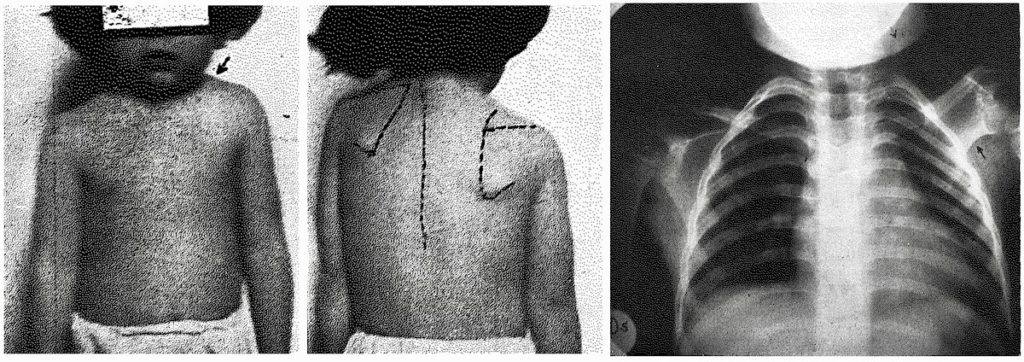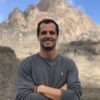Renzo Corno
Renzo Corno Montini (* 1927 – 1965) was an Italian born, Peruvian naturalised pediatric orthopedic surgeon.
He is eponymously remembered for his 1956 description of the autosomal dominant familial form of Sprengel’s deformity known as Corno’s disease
Biography
- Born March 17, 1926 in Italy
- Son of Dr Francesco Montini (1900 – 1971), nephew of Giovanni Battista Enrico Antonio Maria Montini (Pope Paul VI) and Lodovico Montini (1896-1990)
- Suffered intestinal fevers as an infant and was not expected to survive
- 1926 – Moved to Peru with his parents aged 6 months
- 1941 – Attended medical school, aged 15, at the Universidad Nacional Mayor de San Marcos de Lima
- 1948 – Returned to Italy
- 1952 – Orthopedist at Hogar Clínica San Juan de Dios, Lima
- 1958 – Orthopedist at Clínica San Felipe
- Died following a spinal injury on February 11, 1965, aged 38, in Lima, Peru
“Sei in diritto di attendere un solo compenso dagli uomini che vengono a chiederti aiuto, per poveri che essi siano: la loro fiducia. Questa sia per te la maggiore ricchezza.”
Corno Montini R. Primi Incontro col dolore, 1951: 106
“You are entitled to expect but one compensation from the humans that come to ask for your help, poor as they may be: their trust. Let this be for you the greatest treasure”
Corno Montini R. Primi Incontro col dolore, 1951: 106
Medical Eponyms
Corno’s disease (1956)
Autosomal dominant familial form of Sprengel’s deformity.
Renzo Corno presented to the Third International Assembly of the American College of Surgeons a work on the aetiology of the familial nature of congenital high scapula and presented the cases of three siblings from the same family in January 1955. He published the three siblings case notes in 1956.

Il materiale clinico ci viene da una famiglia nella quale due bambine ed un fratellino presentano sintomi e segni di scapola alta congenita. Di questi tre casi si possono trarre alcune conclusioni di una certa importanza :
1) Si presenta per la prima volta nella letteratura medica una scapola alta congenita familiare in tre bimbi, due femmine ed un maschio, di una stessa famiglia.
2) La deformità si accompagna soltanto in due casi di ponte omovertebrale.
3) Si deve accettare l’esistenza di una forma familiare di scapola alta congenita.
The clinical material comes from a family in which two girls and a little brother present symptoms and signs of a congenital high scapula. Of these three cases some conclusions of some importance can be drawn:
1) A congenital high scapula familiar in three children, two females and one male, of the same family, is presented for the first time in the medical literature.
2) Deformity is accompanied in two cases with omovertebral bone.
3) The existence of a familiar form of congenital high scapula must be accepted.
The foundations of his theory of familial inheritance were expanded upon by Arevalo Morey (Faculty of Medicine of Lima in 1956) with more detailed explanation by Morey and Aurora Corno in their 1957 publication [Etiology of Corno’s disease: familial congenital elevated scapula].
Major Publications
- Corno Montini R. Primi incontri col dolore. 1951 (2e 1972)
- Corno Montini R. Il metodo intervallare del Salvioli nel trattamento della poliomielite anteriore acuta [Salvioli’s interval method in the treatment of poliomyelitis]. Minerva pediatrica, 1954; 6(15): 604-607
- Corno R. Scapola alta congenita a carattere familiare [Familial congenital high shoulder]. La Clinica pediatrica (Bologna), 1956; 38(12): 948-952
- CornoMontini R. Fisiopatologia del bambino traumatizzato [Pathophysiology of the traumatized child]. La Clinica pediatrica, 1964 Mar; 46: 235-64
- B Brusoni, GP Sanna, P Fancini, R Corno, G Cupellini. L’ECG dinamico degli immaturi nella prima giornata di vita. Bollettino della Societa italiana di cardiologia, 1980; 25(9): 1092
Controversies
Very little information about Dr Renzo Corno Montini exists. Here are snippets of the documentation available…
1952 – Hogar Clínica San Juan de Dios, Lima
En mayo de 1952 abrió sus puertas, como una entidad privada para la aten-ción integral de los niños discapacitados, principalmente por secuelas poliomielíticas, muy frecuentes en ese entonces, o por lesión cerebral, multiimpedidos con retardo mental, problema de lenguaje, estrabismo y otros de-fectos oculares, infecciones óseas, osteomielitis, mal de Pott y osteoarticulares, luxación de cadera, amputados congénitos, pie bot, etc. Otro grupo de niños estaba constituido por defectos estéticos como el labio leporino, la fisura palatina y las secuelas de quemaduras, cicatrices retráctiles y sinequias. Posteriormente comenzaron a funcionar los servicios de odontología, oftalmología, cirugía de tórax, de cabeza y cuello, de urología, en un principio para el tratamiento de la patología asociada a los impedimentos, motivo principal de la atención. Los primeros en aportar su trabajo voluntario a solicitud de los hermanos de San Juan de Dios fueron el Dr. Belisario Sánchez León, cirujano ortopédico, director fundador y, en orden cronológico, Pedro Angulo Pinto, Juan Celi Coronado (tercer Director Médico). Rómulo Acuña Luna, Alberto Carrión Vergara (cirujano plástico), Roberto Temple S., José Valdivia Arrisueño (Fisiatra), Gino Costa E., en ese entonces Neurólogo (segundo Director), Pedro Zevallos (Neumólogo), Julio Gastiaburú (Laboratorista), José Balestra (Pediatra), Cecilio de la Fuente, Mario Valera, Renzo Corno (Ortopedistas) y Angélica Corvacho (Cardióloga).
In May 1952 it opened its doors as a private entity for the comprehensive care of children with disabilities, mainly due to polio sequelae, very common at the time, or brain injury, multi-impaired with mental retardation, language problems, strabismus and other eye defects, bone infections, osteomyelitis, Pott’s and osteoarticular disease, hip dislocation, congenital amputations, foot bot, etc. Another group of children consisted of aesthetic defects such as cleft lip, cleft palate and the aftermath of burns, retractable scars and synechiae. Later, the services of dentistry, ophthalmology, thoracic surgery, head and neck, urology began to work, initially for the treatment of pathology associated with impediments, the main reason for attention. The first to contribute their voluntary work at the request of the brothers of San Juan de Dios were Dr. Belisario Sánchez León, orthopedic surgeon, founding director and, in chronological order, Pedro Angulo Pinto, Juan Celi Coronado (third Medical Director). Rómulo Acuña Luna, Alberto Carrión Vergara (plastic surgeon), Roberto Temple S., José Valdivia Arrisueño (Physiatrist), Gino Costa E., then Neurologist (second Director), Pedro Zevallos (Pulmonologist), Julio Gastiaburú (Laboratory), José Balestra (Pediatrician), Cecilio de la Fuente, Mario Valera, Renzo Corno (Orthopedist) and Angélica Corvacho (Cardiologist).
1958 – Clínica San Felipe, Lima
On September 5, 1958, a group of prominent doctors started the project that is known today as the Clínica San Felipe. From the beginning, its founders strived to build a clinic that encompassed various medical specialties and that offered a quality comprehensive service to its patients:
Dr. Carlos Blondet Goicochea, Dr. Renzo Corno Montini, Dr. Aldo Raffo Uzátegui, Dr. Carlos Roe Gómez, Dr. Juan Franco Ponce, Dr. Roger Pinillos Ganoza, Dr. Neptalí Pastor Guajardo, Dr. René Gastelumendi Vearde, Dr. Raúl León Barúa, Dr. Vicente Chiang Chiang and Dr. Jesús Morán Valdiviezo laid the foundations so that for more than 50 years the San Felipe Clinic continues to be recognized as the leading private medicine clinic in Peru.
1965 Death notice Dr Renzo Corno Montini
References
Biography
- Corno Montini R. Primi Incontro col dolore; 1951: 16-19
- Pope Paul VI (Giovanni Battista Enrico Antonio Maria Montini) (1897-1978)
- Universidad Nacional Mayor de San Marcos. Historia de la medicina peruana en el siglo XX, Volume 1. 2000
- César Zaldívar Sobrado. Historia de la ortopedia y de la traumatología en el Perú. 2002
Eponymous terms
- Greig DM. Congenital High-Scapula, with Which Is Included a Consideration of Brevicollis. Edinb Med J. 1924 Jan; 31(1): 22–44.
- Morey Arevalo A, Corno Aurora. [Etiology of Corno’s disease: familial congenital elevated scapula]. La Clinica pediatrica (Bologna), 1957 Feb; 39(2): 145-55
Resident medical officer in emergency medicine MB ChB (Uni. Dundee) MRCS Ed. Avid traveller, yoga teacher, polylinguist with a passion for discovering cultures.


